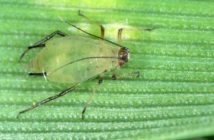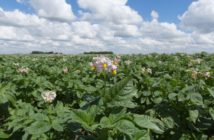Bayer trials are a reminder of the importance of glyphosate timing, dose and application best practice.
In the demo at the NIAB black grass management site in Lincolnshire, poor glyphosate application practice consisted of a low dose rate (1.5L/ha of a 360g/L product) at 2+ weeks before drilling. Good practice was a suitable rate for the control of tillering grassweeds (3.0L/ha of a 360g/L product) within one week of drilling. The demo also looked at the interaction with good and poor weed management strategy relating to drilling date, rotation and selective herbicide use.
“Appropriate timing, dose and application quality of Roundup have a significant impact on weed problems in the crop,” says Bayer agronomist Roger Bradbury. “From a starting point of five plants/m2, blackgrass numbers rapidly escalated over two seasons with poor use of Roundup.”
“Poor management choices can quickly cause a huge increase in weed populations. Effective use of Roundup pre-drilling had a huge impact on overall weed numbers, irrespective of the weed management strategy. Clearly the aim is for good practice across the board, but the results of the demo show that applying Roundup properly at the correct rate and timing pays dividends. Best practice use on farm also helps minimise the risk of selecting for reduced sensitivity and potential resistance development on your farm.”
Applications pre-drilling typically target small grassweeds, 540g/ha active ingredient (equivalent to 1.5L/ha of a 360g/L product) is suitable for blackgrass seedlings only. Italian ryegrass and brome need 720g/ha as the minimum starting point. Larger weeds which may have started to tiller need higher rates.
“Assess the situation carefully to avoid underdosing. Don’t try to compensate for a lower rate by adding mix partners of adjuvants,” says Roger.
Application and formulation both play a part in getting glyphosate where it needs to be – the growing shoots and roots of the plant. Aim for a boom height of 0.5m above the target and forward speed of no more than 12km/hour to get even deposition on the leaf.
“Using Roundup-branded glyphosate helps ensure more reliable efficacy. It uses glyphosate in the potassium salt (K-salt) form, which is a smaller molecule than the IPA-salt of many other products. This means there is more capacity to include surfactants in the formulation to improve performance.”
The surfactant system in Roundup minimises effects at the leaf surface and maximises uptake. It also improves speed of activity, rainfastness and reduces cultivation intervals.
Roger adds that glyphosate efficacy and stewardship are more important than ever following the announcement of resistance earlier this year. He encourages farmers and agronomists to take note of the WRAG guidelines around the use of glyphosate pre-drilling.
“Use a maximum of two applications in total, with cultivation or another form of weed control in between to eliminate survivors. Don’t make repeat applications to the same weeds and investigate any instances of poor control.”
Managing green bridge
Aphid vectors of BYDV survive in cereal volunteers. Spraying off any volunteers is an important first line of defence against BYDV. But unlike weed control, a longer gap between spray off and drilling is better, so there is no green bridge where the aphids can survive until the crop is drilled.
“In our trials, a ten-day gap was better than a two-day gap for preventing yield loss from BYDV. For weed control, the optimum is a week or less so it’s a balancing act and a lot depends on whether weeds or BYDV are a bigger threat in a particular field. There are more resistant varieties now which can help manage the risk.”




